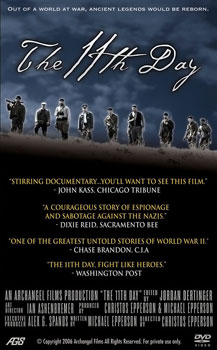The 11th Day: Crete 1941
| The 11th Day: Crete 1941 | |
|---|---|
 | |
| Directed by | Christos Epperson |
| Written by | Michael Epperson |
| Produced by | Christos Epperson Michael Epperson |
| Cinematography | Ian Ashenbremer |
| Edited by | Jordan Dertinger |
Release date |
|
| Country | United States |
| Languages | English and Greek |
The 11th Day: Crete 1941 is a 2005 documentary film featuring eyewitness accounts from survivors of the
Plot
On May 20, 1941, thousands of elite German paratroopers, the Fallschirmjäger, assaulted the island of Crete.[2] It was the beginning of one of the largest paratrooper assaults in modern history, ultimately involving 22,040 German soldiers.[3] It was also the first time German troops faced a unified resistance from a civilian populace.[4] The Battle of Crete would become the largest German airborne operation of World War II, known as "Operation Mercury," (German: Luftlandeschlacht um Kreta, also Unternehmen Merkur, Greek: Μάχη της Κρήτης).
The Germans had expected to control the island within a few days; after all, in less than seven weeks they had defeated
Historically significant operations documented in the film
With the help of a handful of British agents of the
Production
Pre-production for the project began in 2000, when producer-director Christos Epperson and his brother, writer-producer Michael Epperson began to document the history of their great aunts and uncles—three brothers and their two sisters—who fought with the Cretan resistance in Chania.
Release
The film premiered on September 28, 2005 in Chicago,[15] beginning a tour of theaters throughout the United States and Canada.[16][17] In November 2006, the film was released on DVD with Greek and English-language tracks. A photo gallery of over 500 images is also included. The film is available in libraries as well as through commercial online retailers. On the official film website, the producers have made available their collection of research material. Included are over 2000+ photos, of which many are rare and unpublished. It is the perhaps one of the largest online archive of World War II photos and documents in the world.
Sources
- Tomadakis, Nikolaos V. (1957). "†Αγαθάγγελος Ξηρουχάκης (1872-1958). Βιογραφικόν και βιβλιογραφικόν σημείωμα". Kritika Chronika (in Greek). 11.
- Reid, D. “For Sacramento brothers, making ‘The 11th Day: Crete 1941’ was personal.” The Sacramento Bee, 9 December 2005, p.27-28.
- Kass, J. “Movie gives life to little told tale of WWII heroism.” The Chicago Tribune, 25 September 2005.
- Knight, C. “Heroes fight like Greeks” National Post, Toronto Edition, 29 October 2005
- Beevor, A: Crete: The Battle and the Resistance, Second Edition, Westview Press, 1994
References
- ^ "Clipped from Chicago Tribune". Chicago Tribune. 23 September 2005. pp. 7A–8.
- ^ Beevor, A: Crete: The Battle and the Resistance, Second Edition, Westview Press, 1994
- ISBN 0-14-016787-0.
- ^ Maloney, Shane (July 2006). "Bogin, Hopit". The Monthly.
- ISBN 978-0-192-80550-8.
- ISBN 1-86019-964-X.
- ^ Beevor, A: Crete: The Battle and the Resistance, Ch. 9, 'A fine opportunity for killing,' pgs. 116-118, Second Edition, Westview Press, 1994
- ^ Beevor, A: Crete: The Battle and the Resistance, Ch. 6, 'A second Scapa,' pgs. 69-71, Second Edition, Westview Press, 1994
- ^ Beevor, A: Crete: The Battle and the Resistance, Ch. 24, "The years of change," p. 262, Second Edition, Westview Press, 1994.
- ^ William Stanley Moss, Patrick Leigh Fermor (2005). The 11th Day: Crete 1941 (Film). Crete: Archangel Films. Archived from the original on 2013-10-07. Retrieved 2018-05-09.
- ^ Beevor, A: Crete: The Battle and the Resistance, Ch. 26, 'The abduction of General Kreipe,' pgs. 303-311, Second Edition, Westview Press, 1994
- ^ Reid, D. “For Sacramento brothers, making ‘The 11th Day: Crete 1941’ was personal.” The Sacramento Bee, 9 December 2005, p.27-28.
- ^ Tomadakis, Nikolaos V. (1957). "†Αγαθάγγελος Ξηρουχάκης (1872-1958). Βιογραφικόν και βιβλιογραφικόν σημείωμα". Kritika Chronika (in Greek). 11.
- ^ Reid, D. “For Sacramento brothers, making ‘The 11th Day: Crete 1941’ was personal.” The Sacramento Bee, 9 December 2005, p.27-28.
- ^ Kass, J. “Movie gives life to little told tale of WWII heroism.” The Chicago Tribune, 25 September 2005.
- ^ Knight, C. “Heroes fight like Greeks” National Post, Toronto Edition, 29 October 2005
- ^ Reid, D. “For Sacramento brothers, making ‘The 11th Day: Crete 1941’ was personal.” The Sacramento Bee, 9 December 2005, p.27-28.
External links
- Official website Archived 2013-10-07 at the Wayback Machine
- Beevor, A. 1994. Crete: The Battle and the Resistance
- The Benaki Museum's acquisition of Leigh Fermor's home in Kardamyli, Mani, Greece
- Kiriakopoulos, G. 1995. The Nazi Occupation of Crete 1941-1945
- The 11th Day: Crete 1941 at IMDb
- Michael Epperson, California State University Sacramento
- Chicago Tribune
- Sacramento Bee
